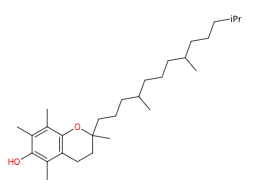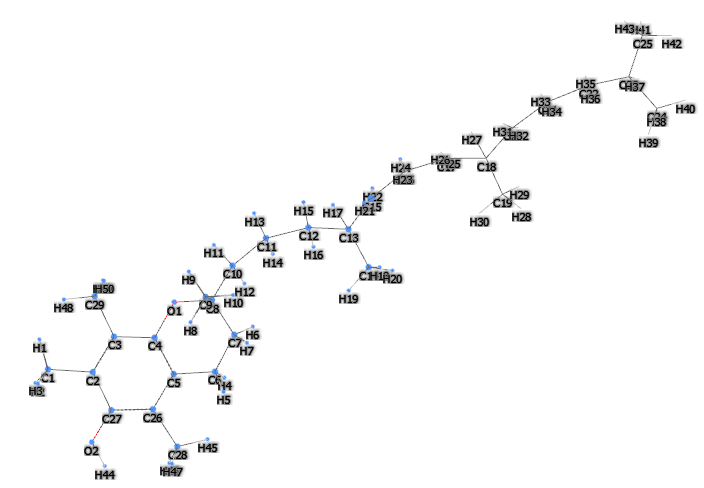| "Descrizione" by A_Partyns (12948 pt) | 2023-Oct-20 21:12 |
Review Consensus: 8 Rating: 8 Number of users: 1
| Evaluation | N. Experts | Evaluation | N. Experts |
|---|---|---|---|
| 1 | 6 | ||
| 2 | 7 | ||
| 3 | 8 | ||
| 4 | 9 | ||
| 5 | 10 |
Alpha tocopherol is one of the four isomer components that constitute tocopherol: alpha-tocopherol, beta-tocopherol, delta-tocopherol and/or gamma-tocopherol.
Alpha tocopherol occurs naturally in cereals, in oils and, in particular in:
- olive oil
- wheat germ oil
- palm oil
- soybean oil
- corn oil
- sunflower oil
- eggs
- butter
- peanuts
- almonds and other dried fruit
It is a fundamental antioxidant and can be created using a chemical process.
Its antioxidant action has effects on the brain (1), when, in the cardiovascular system, there are problems of diabetes caused by LDL cholesterol (2) and in liver diseases (3)
In the medical field it is an adjuvant to treat vascular diseases, as prevention for cellular diseases and for a correct functioning of the immune system.
No positive action, however, was found towards prostate cancer, as demonstrated by this study of very long duration on many samples (4).
What it is used for and where
Medical
Its antioxidant action has effects on the brain (1), when, in the cardiovascular system, there are problems of diabetes caused by LDL cholesterol (2) and in liver diseases (3)
In the medical field it is an adjuvant to treat vascular diseases, as prevention for cellular diseases and for a correct functioning of the immune system.
No positive action, however, was found towards prostate cancer, as demonstrated by this study of very long duration on many samples (4).
Food
Ingredient included in the list of European food additives as E307, antioxidant.
Cosmetics
Antioxidant agent. Ingredient that counteracts oxidative stress and prevents cell damage. Free radicals, pathological inflammatory processes, reactive nitrogen species and reactive oxygen species are responsible for the ageing process and many diseases caused by oxidation.
Fragrance. It plays a decisive and important role in the formulation of cosmetic products as it provides the possibility of enhancing, masking or adding fragrance to the final product, increasing its marketability. The consumer always expects to find a pleasant or distinctive scent in a cosmetic product.
Skin conditioning agent - Miscellaneous. This ingredient has the task of modifying the condition of the skin when it is damaged or dry by reducing its flakiness and restoring its elasticity.
Skin conditioning agent - Occlusive. This ingredient has the task of modifying the condition of the skin when it is damaged or dry by reducing flaking and restoring elasticity. It has a strong lipophilic character and is identified as an occlusive ingredient; it is generally composed of oily and fatty materials that remain on the skin surface and reduce trans epidermal water loss.
 |  |
- Molecular Formula: C29H50O2
- Molecular Weight: 430.717 g/mol
- CAS: 59-02-9
- EC Number: 200-201-5 200-412-2
- UNII: N9PR3490H9
- PubChem Substance ID 24899979
- MDL number MFCD00072045
- Beilstein Registry Number 4712525
- DSSTox ID DTXSID0026339
- IUPAC (2R)-2,5,7,8-tetramethyl-2-[(4R,8R)-4,8,12-trimethyltridecyl]-3,4-dihydrochromen-6-ol
- InChl=1S/C29H50O2/c1-20(2)12-9-13-21(3)14-10-15-22(4)16-11-18-29(8)19-17-26-25(7)27(30)23(5)24(6)28(26)31-29/h20-22,30H,9-19H2,1-8H3/t21-,22-,29-/m1/s1
- InChl Key GVJHHUAWPYXKBD-IEOSBIPESA-N
- SMILES CC1=C(C2=C(CCC(O2)(C)CCCC(C)CCCC(C)CCCC(C)C)C(=C1O)C)C
- ChEBI 18145
- NACRES NA.75
- eCl@ss 34058016
- Nikkaji J24.260H
- NCI C68313 C2832 C74960
- RXCUI 237099 1236136 11256
- Metabolomics Workbench 29096
- Pharos Ligand 85BJCGZ83ZT5
Synonyms:
- alpha-Tocopherol
- a-Tocopherol
- D-alpha-Tocopherol
- (2R,4'R,8'R)-alpha-Tocopherol
- 59-02-9
- dl-a-Tocopherol
- 5,7,8-Trimethyltocol
- (+)-alpha-Tocopherol
- (R,R,R)-alpha-Tocopherol
- DL-ALPHA-TOCOPHEROL
- Vitamin Ea
- Mixed tocopherols
- D-alpha tocopherol
- Syntopherol
- Denamone
- Viteolin
- Esorb
- Tocopherol (R,S)
- 2,5,7,8-Tetramethyl-2-(4',8',12'-trimethyltridecyl)-6-chromanol
- Aquasol E
- 10191-41-0
- (+)-|A-Tocopherol
- Tocopherol alpha
- a-Vitamin E
- (2R)-2,5,7,8-TETRAMETHYL-2-[(4R,8R)-4,8,12-TRIMETHYLTRIDECYL]CHROMAN-6-OL
- 2074-53-5
- Profecundin
- Waynecomycin
- Vitamin E alpha
- Vitaplex E
- N9PR3490H9
- Vita E
- EINECS 215-798-8
- Lan-E
- Med-E
- (R)-2,5,7,8-Tetramethyl-2-((4R,8R)-4,8,12-trimethyltridecyl)chroman-6-ol
- Antisterility vitamin
- alpha-Tocopherol acid
- Tenox GT 1
- Endo E
- Eprolin S
- Viterra E
- CHEBI:18145
- E Prolin
- Spavit E
- 2H-1-Benzopyran-6-ol, 3,4-dihydro-2,5,7,8-tetramethyl-2-[(4R,8R)-4,8,12-trimethyltridecyl]-, (2R)-
- Almefrol
- Emipherol
- Epsilan
- Etamican
- Tokopharm
- Vascuals
- Viprimol
- Vitayonon
- Etavit
- Ilitia
- Verrol
- Evion
- alpha-Tokoferol
- (2R)-2,5,7,8-tetramethyl-2-[(4R,8R)-4,8,12-trimethyltridecyl]-3,4-dihydro-2H-chromen-6-ol
- 3,4-Dihydro-2,5,7,8-tetramethyl-2-(4,8,12-trimethyltridecyl)-2H-benzopyran-6-ol
- BPBio1_000362
- alpha-Vitamin E
Abstract. Brain-derived neurotrophic factor (BDNF) is involved in the proliferation of neurons, and its expression increases significantly with exercise. We aimed to investigate the effects of chronic exercise (swimming) and sustained hypoxia on cortical BDNF expression in both the presence and absence of vitamin E. Sixty four male Sprague-Dawley rats were divided into two equal groups; a normoxic group and a hypoxic group. Both groups were equally subdivided into four subgroups: sedentary, sedentary with vitamin E, chronic exercise either with or without vitamin E supplementation. Arterial PO(2), and the levels of cortical malondialdehyde (MDA), antioxidants (reduced glutathione GSH, superoxide dismutase (SOD), catalase (CAT) and vitamin E) and BDNF gene expression were investigated. Hypoxia significantly increased MDA production and BDNF gene expression and decreased the antioxidants compared to control rats. Chronic exercise in hypoxic and normoxic rats increased MDA level and BDNF gene expression and decreased the antioxidants. Providing vitamin E supplementation to the hypoxic and normoxic rats significantly reduced MDA and BDNF gene expression and increased antioxidants. We conclude that sustained hypoxia and chronic exercise increased BDNF gene expression and induced oxidative stress. Moreover, vitamin E attenuated the oxidative stress and decreased BDNF gene expression in sustained hypoxia and chronic exercise which confirms the oxidative stress-induced stimulation of BDNF gene expression.
Abstract, Hyperlipidemia and oxidized-low-density lipoproteins (Ox-LDL) are important independent cardiovascular risk factors that have been shown to stimulate vascular smooth muscle cell (VSMC) proliferation. The purpose of the present study was to investigate the effect of vitamin E on Ox-LDL, lipid profile, C-reactive protein (CRP), and VSMC proliferation of rat aorta.....Conclusions: These findings strongly support the idea that diabetes induces Ox-LDL-mediated oxidative stress and VSMC proliferation in aorta of rat and imply that vitamin E has a strong protective effect as an antioxidant.
Abstract. Oxidative stress has been investigated in the context of alcoholic liver injury for many years and shown to be a causal factor of chronic hepatitis C (CHC), nonalcoholic steatohepatitis (NASH), drug-induced liver injury, Wilson's disease, and hemochromatosis. In CHC, it has been demonstrated that oxidative stress plays an important role in hepatocarcinogenesis. In cases with persistent hepatitis due to failure of hepatitis C virus eradication, or chronic liver disease, such as NASH, the treatment of which remains unestablished, it is important to reduce serum alanine aminotransferase levels and prevent liver fibrosis and development of hepatocellular carcinoma. This also suggests the importance of antioxidant therapy. Among treatment options where it would be expected that anti-inflammatory activity plays a role in their confirmed efficacy for chronic hepatitis, iron depletion therapy, glycyrrhizin, ursodeoxycholic acid, Sho-Saiko-To, and vitamin E can all be considered antioxidant therapies. To date, however, the ability of these treatments to prevent cancer has been confirmed only in CHC. Nevertheless, anti-inflammatory and anti-fibrotic effects have been demonstrated in other liver diseases and these therapies may potentially be effective for cancer prevention.
Abstract. Recent studies have reported that remote organs are affected by renal ischemia reperfusion (IR). The present study investigates the role of vitamin E on the liver damage after renal IR. First, male mice were subjected to three groups (n = 9): 1) sham-operated, (2) renal IR (45 min ischemia), (3) renal IR + Vitamin E (150 mg/kg trough feeding tube for 28 d). After 24 h of reperfusion, animal were anesthetized for sample collections. Liver tissues malondialdehyde (MDA) increased and total glutathione (GSH) concentration decreased in the IR group compared to the sham group. Vitamin E consumption diminished the IR-induced increase in plasma AST and ALT. In addition, Vitamin E inhibited the IR-induced decrease in GSH activity and diminished IR-induced increase in MDA concentration. These findings showed that vitamin E consumption partly inhibited the IR-induced liver damage.
Abstract, There are several studies that relate oxidative damage as possible mechanism for many cancers. Many studies have also shown that anti-oxidants like selenium and vitamin E decrease the risk for prostate cancer. The main objective of the Selenium and Vitamin E Cancer Prevention Trial (SELECT) study was to look for the benefits of selenium and vitamin E supplementation on prostate cancer. The study had a large sample size, stringent experimental conditions, very long duration, standardized laboratories for biochemical analyses and other factors that contribute to high external validity. The SELECT study failed to show any significant risk reduction for prostate cancers ascribable to selenium and vitamin E supplementations. Because of these conflicting results, many researchers argue about the methods used, supplementations administered (selenium and vitamin E) and indicators used for assessing levels of supplementations. We reviewed many epidemiological studies, clinical trials, and pre-clinical studies. With corroborative evidences we justify that SELECT study has a sound methodology and rationale. In lieu of the contrary results of the select study, researchers should focus on the probable mechanisms for these contrary findings and continue their search for newer and effective agents for prevention of prostate cancer.
| Evaluate |

